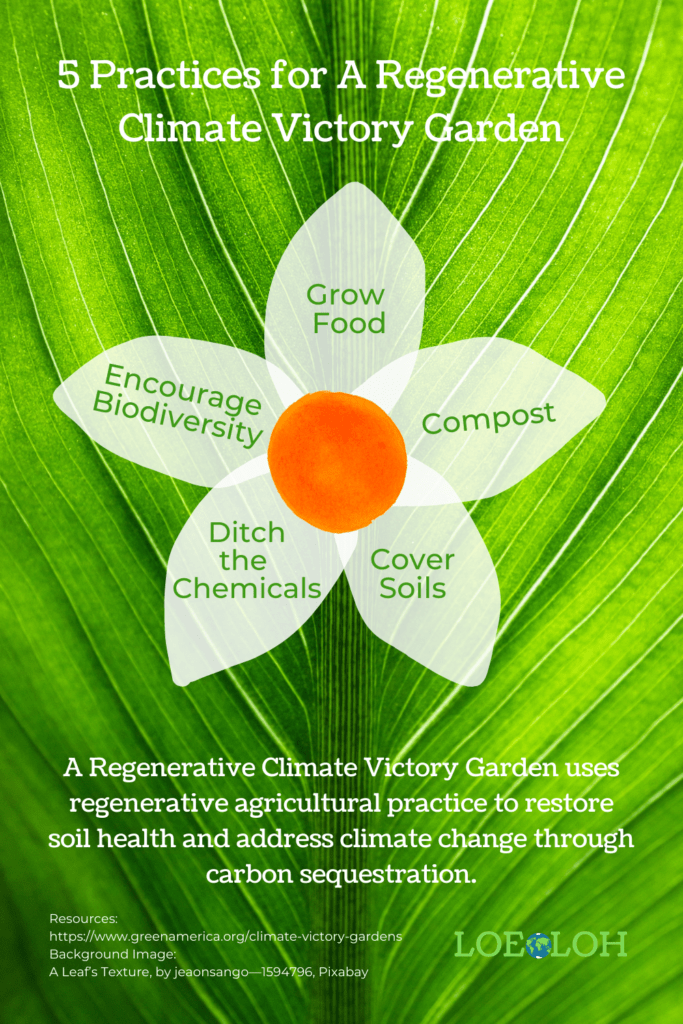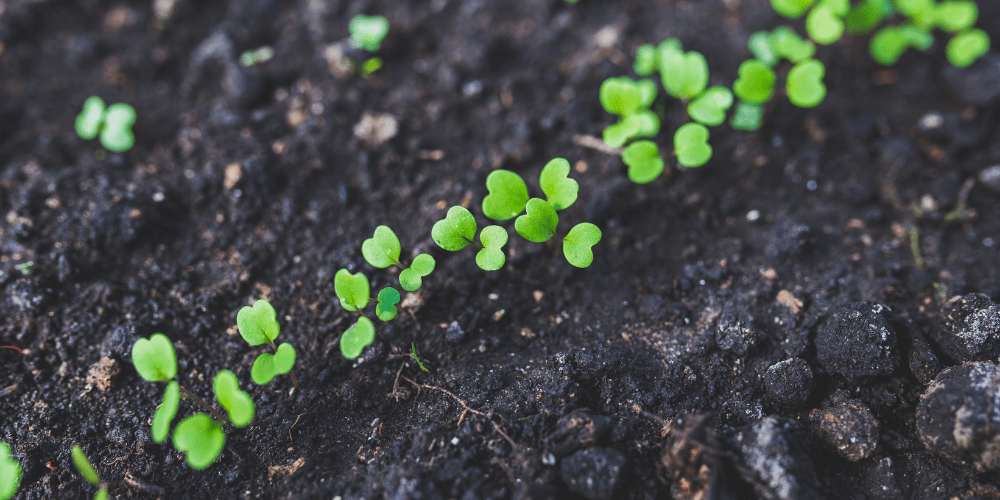A Regenerative Climate Victory Garden uses regenerative agricultural practice to restore soil health and address climate change. Restoring soil health in our home gardens provides multiple benefits. It increases the nutrients in the soil, rejuvenates the health of soil microbes, and improves water retention in soil.
When soil is healthier it can store more carbon, this is known as carbon sequestration. Carbon sequestration is when carbon dioxide is pulled from the atmosphere and stored as other forms of carbon. Carbon can be sequestered in soil, the oceans, and living creatures. When carbon dioxide is removed from the atmosphere it is no longer contributing to global warming. Carbon sequestration is vital in addressing climate change.
The Regenerative Climate Victory Garden program was started as a collaboration between Green America and Kiss the Ground. The program was inspired by the Victory Gardens that began after World War II. In 1944 about 40% of all the fruits and vegetables consumed in the United States were grown in backyards.
Now, how do you grow a Regenerative Climate Victory Garden? These are the 5 practices from the Regenerative Climate Victory Garden program to get you started.

5 Practices for your Regenerative Climate Victory Garden
1. Grow Food
Start with growing food. Growing a garden requires some work, so reward yourself by growing food. If you have never eaten a fresh tomato from a garden, ooh are you in for a treat. Often, when growing food, your garden will likely produce a surplus. Share your abundance with family, friends, or local food banks.
Grow food that is often expensive in the grocery store like herbs. Fresh herbs can be a delightful addition to your home cooked meals.
Even better, grow perennial fruits, vegetables, and herbs for a lower maintenance supply of food.
2. Cover Soils
Keep your soil covered with mulch, compost, plants, or plant debris. This helps the soil retain moisture, increase nutrients, and prevents erosion. These benefits also maintain the microbes that live in the soil and improves soil health.
Exposed dirt is also an opportunity for plants to grow. When plants grow, they are pulling carbon dioxide out of the air and storing the carbon as plant matter. Covering soils by allowing cover plants to grow rather than leaving an empty patch of dirt increases carbon sequestration.
3. Compost
Put your organic waste to good use by composting it. When organic waste, like kitchen scraps and yard waste, decomposes in landfills, methane (a powerful greenhouse gas) is released. However, when organic waste is composted either at home or in industrial facilities, it is less likely to produce methane. Compost is also nutrient rich and can be used in place of fertilizer.
In addition, adding compost to our gardens, feeds the microbes in the soil. These microbes help store carbon in soil, preventing carbon being released as carbon dioxide.
4. Ditch the Chemicals
Stop using chemicals in your garden. Ron Finley says it best, “If you don’t want it in your body, don’t put it in your food.” Synthetic chemicals frequently used in gardening including herbicides, pesticides, and fertilizers have wide spread harmful effects.
Herbicides in addition to killing plants, can be harmful to humans. People exposed to glyphosphate, an ingredient in herbicides like Round Up, are more likely to develop Lymphoma (a type of cancer) than those who are not exposed.
Pesticides used to kill insects and plants, are also harmful to other wildlife. They are a major contributing factor to the decrease in bee populations.
Fertilizers provide nutrients to plants through absorption in the soil. Synthetic fertilizers that are not absorbed by plants often runs off into nearby water ways. The added nutrients from synthetic fertilizers can result in toxic algal blooms in lakes and rivers. These blooms can be dangerous to both wildlife and humans.
The use of synthetic chemicals decreases the nutrients in soil and kills essential microbes that live in soil. Healthy soil microbes are vital to plant health. When microbes in soil are healthy, they provide vital nutrients like nitrogen and phosphate to plants.
5. Encourage Biodiversity
Encourage biodiversity with a wide array of plants, using compost as fertilizer, and growing plants for pollinators. A diversity of plants will make your garden more resilient to pests. Different kinds of plants will also encourage a more diverse population of soil microbes.
Plant perennials along with annuals. Planting perennials decreases how much soil is disturbed and keeps soil microbes happy. When perennials are allowed to establish, their roots store carbon deeper in the soil.
If you already have a Regenerative Climate Victory Garden, add it to the map of Climate Victory Gardens. So far they have over 4,000 gardens registered which equals about nearly 11,000 tons of carbon sequestered in the soil.
When we start using these 5 practices in our home gardens we are able to restore the health of our garden and store carbon in the soil. Go get your Regenerative Climate Victory Garden growing!
Image Credit: Home gardening – young rucola – top view, Kaboompics.com, Pexels


